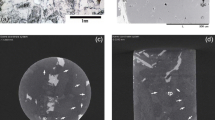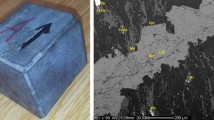Abstract
The P-wave velocities and electrical conductivities of gabbro were measured using ultrasonic transmission method and impedance spectroscopy from room temperature to 1100°C at 1–2 GPa, and the factors controlling the P-wave velocity and the microscopic conductance mechanisms of the rock were analyzed. The experimental results show that the P-wave velocities of gabbro drop abruptly at temperatures of 800-850°C and under pressures of 1–2 GPa due to the occurrence of grain boundary phases and dehydration melting; however, the electrical conductivities and electronic conduction mechanisms have not changed obviously at temperatures of 800–850°C. At temperatures Below 680°C, only one impedance arc (I) corresponding to grain interior conduction occurs at frequencies between 12 Hz and 105 Hz, the second arc (II) corresponding to grain boundary conduction occurs at temperatures above 680°C. The total conductivity of this rock is dominated by the grain interior conductivity as the occurrence of grain boundary conduction has a small effect on the total conductivity. The laboratory-measured velocities are consistent with the average P-wave velocity observations of lower crust and upper mantle. The conductivity values correspond well with the gabbroite composition of the lower crust and upper mantle; however, they are about 1-2 orders of magnitude lower than MT data from the high conductive layers. The experiments confirm that the dehydration of hydrous minerals can induce the partial melting, and the low seismic velocity zones might be correlated with the high conductive layers if partial melting occurs.
Similar content being viewed by others
References
Zijl, J., A deep Schlumberger sounding to investigate the electrical structure of the crust and upper mantle in South Africa, Geophysics, 1969, 34: 450–162.
Jones, A. G., Gough, D. I., Kurtz, R. D. et al., Electromagnetic images of regional structure in the southern Canadian Cordillera, Geophys. Res. Lett., 1992, 12: 2373–2376.
Sato, H., Ida, Y., Low frequency electrical impedance of partially molten gabbro: The effect of melt geometry on electrical properties, Tectonophys., 1984, 107: 105–134.
Sato, H., High temperature a.c. electrical properties of olivine single crystal with varying oxygen partial pressure: Implications for the point defect chemistry, Phys. Earth Planet. Inter., 1986, 41: 269–282.
Roberts, J. J., Tyburczy, J. A., Partial-melt electrical conductivity: Influence of melt composition, J. Geopys. Res., 1999, 104: (B4): 7055–7065.
Matsushima, S., Partial melting of rocks observed by the sound velocity method and the possibility of a quasi-dry low velocity zone in the upper mantle, Phys. Earth Planet. Inter., 1989, 55: 306–312.
Lebedev, E. B., Kern, H., The effect of hydration reactions on wave velocities in basalts, Tectonophys., 1999, 308: 331–340.
Liu Yonggang, Xie Hongsen, Guo Jie et al., A new method for experimental determination of compressional velocities in rocks and minerals at high pressure, Chin. Phys. Lett., 2000, 17(12): 924–926.
Song Maoshuang, Xie Hongsen, Zheng Haifei et al., Determination of serpentine dehydration temperature at 1–5 GPa by the method of electrical conductivity, Chinese Science Bulletin, 1996, 41(21): 1815–1819.
Deng Jinfu, Phase Equilibrium of Rock and Generation of Rock (in Chinese), Wuhan: Geological Institution of Wuhan Press, 1986, 1–37.
Huebner, S. J., Dillenaurg, G. D., Impedance spectra of dry silicate minerals and rock: Qualitative interpretation of spectra, Am. Miner., 1995, 80: 46–64.
Wanamaker, B. J., Duba, A. G., Electrical conductivity of San Carlos olivine along [100] under oxygen- and pyroxenebuffer conditions and implications for defect equilibria, J. Geophys. Res., 1993, 98(B1): 489–500.
Roberts, J. J., Tyburczy, J. A., Frequency dependent electrical properties of polycrystalline olivine compacts, J. Geophys. Res., 1991, 96(B10): 16205–16222.
MacDonald, J. R., Johnson, W. B., Impedance Spectroscopy—Emphasizing Solid Material System, New York: Wiley & Sons, 1987, 1–26.
MacDonald, J. R., Generalizations of “universal dielectric response” and a general distribution-of-activation-energies model for dielectric and conducting systems, J. Appl. Phys., 1985, 58: 1971–1978.
Xu, Y-S, Poe, B., Shankland, T. J. et al., Electrical conductivity of olivine, wadsleyite, and ringwoodite under uppermantle conditions, Science, 1998, 280: 1415–1418.
Schock, R. N., Duba, A. G., Heard, H. C. et al., The electrical conductivity of polycrystalline olivine and pyroxene under pressure, in High-Pressure Research: Applications in Geophysics (eds. Manghnani, M. H., Akimoto, S. I.), New York, San Francisco, London: Academic Press, 1977, 39–51.
Watanabe, T., Kurita, K., The relationship between electrical conductivity and melt fraction in a partially molten system: Arche’s law behavior, Phys. Earth Planet. Inter., 1993, 78: 9–17.
Hirsch, L. M., Shankland, T. J., Quantitative olivine-defect chemical model: Insights on electrical conduction, diffusion, andthe role of Fe content, Geophys. J. Int., 1993, 114: 21–35.
Dobson, D. P., Brodholt, J. P., The electrical conductivity of the lower mantle phase magnesiowustite at high temperatures and pressures, J. Geophys. Res., 2000, 105(Bl): 531–538.
Christensen, N. I., Compressional wave velocities in possible mantle rocks to pressures of 30 kilobars, J. Geophys. Res., 1974, 79(2): 4407–1412.
Li, X.-Y., Ming, L. C., Manghnani, M.-H., Pressure dependence of the electrical conductivity of (Mg9sFe0.1)SiO3 perovskite, J. Geophys. Res., 1993, 98(B1): 501–508.
Huebner, S. J., Voigt, D. E., Electrical conductivity of diopside: Evidence for oxygen vacancies, Am. Miner., 1988, 73: 1235–1254.
Richet, P., Ingrin, J., Mysen, B. O., Premelting effects in minerals: An experimental study, Earth Planet. Sci. Lett., 1994, 121(4): 337–345.
Roberts, J. J., Tyburczy, J. A., Impedance spectroscopy of single and polycrystalline olivine: Evidence for grain boundary transport, Phys. Chem. Minerals, 1993, 20: 19–26.
Chiou, B. S., Lin, S. T., Duh, J. G. et al., Equivalent circuit model in grain-boundary barrier layer capacitors, J. Am. Ceram. Soc., 1989, 72:1967–1975.
Drury, M. R., Fitz Gerald, J. D., Mantle rheology: Insights from laboratory studies of deformation and phase transition, in The Earth’s Mantle: Composition, Structure and Evolution (ed. Jackson, I.), Cambridge: Cambridge University Press, 1998, 503–558.
Grover, C. R. M., Grain boundaries in semiconductors, J. Phys. C., 1985, 18: 4079–4119.
Christensen, N. I., Mooney, W. D., Seismic velocity structure and composition of the continental crust: A global view, J. Geophys. Res., 1995, 100(B7): 9761–9788.
Rudnick, R. L., Making continental crust, Nature, 1995, 378: 571–578.
Marquis, G., Hyndman, R. D., Geophysical support for aqueous fluids in the deep crust: Seismic and electrical relationships, Geophys. J. Int., 1992, 110: 91–105.
Lastovickova, M., A review of laboratory measurements of the electrical conductivity of rocks and minerals, Phys. Earth. Planet. Inter., 1991, 66: 1–11.
Filloux, J. H., Magnetelluric experiment over the Rose area, J. Geophys. Res., 1982, 87: 8363–8378.
Gough, D. I., Seismic reflectors, conductivity, water and stress in the continental crust, Nature, 1986, 323: 143–144.
Li Qinghe, Zhang Yuansheng, Tu Yiminet al., The combined interpretation of crustal velocity and electrical resistivity in Qilianshan Moutain-Hexi Corridor region, Chinese J. Geophys, 1998, 41: 215–227.
Hyndman, R. D., Shearer, P. M., Water in the lower continental crust: Modelling magnetotelluric and seismic reflection results, Geophys. J. Int., 1989, 98: 343–365.
Mitchell, B. J., Landisman, M., Electrical and seismic properties of the earth’s crust in the southwestern great plains of the USA, Geophys., 1971, 36: 363–381.
Hyndman, R. D., Klemperer, S. L., Lower-crustal porosity from electrical measurements and inferences about composition from seismic velocities, Geophys. Res. Lestt, 1989, 16: 255–258.
Schmeling, H., Numerical model on the influence of partial melt on elastic, anelastic and electrical properties of rocks (Part II)—Electrical conductivity, Phys. Earth Planet. Inter., 1986, 43: 123–136.
Waff, H, S., Theoretical considerations of electrical conductivity in a partially molten mantle and implications for geothermometry, J. Geophys. Res., 1974, 79(26): 4003–010.
Author information
Authors and Affiliations
Corresponding author
Rights and permissions
About this article
Cite this article
Bai, L., Du, J., Liu, W. et al. Experimental studies of electrical conductivities and P-wave velocities of gabbro at high pressures and high temperatures. Sci. China Ser. D-Earth Sci. 46, 895–908 (2003). https://doi.org/10.1360/01yd0441
Received:
Issue Date:
DOI: https://doi.org/10.1360/01yd0441




